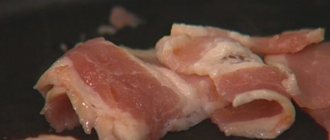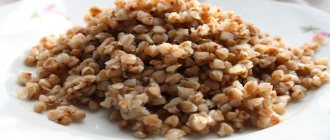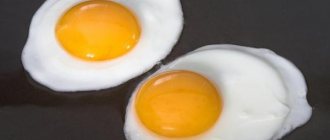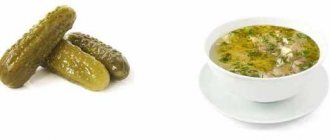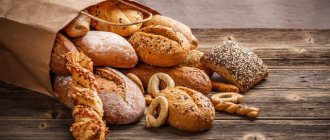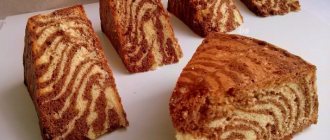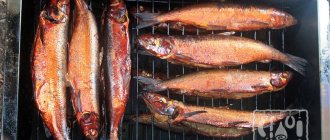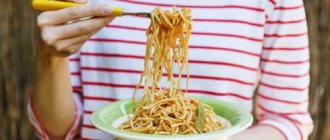Properties of spaghetti
Nutritional value and composition | Vitamins | Minerals
How much does spaghetti cost (average price for 1 kg)?
Moscow and Moscow region.
35 rub.
Italy is considered the birthplace of this long thin pasta, where spaghetti is usually served with tomato sauce. In general, this type of pasta, which the Italians dubbed the word “Pasta,” is characterized by a round cross-section, approximately 2 millimeters in diameter, and more than 25 centimeters in length. Thinner spaghetti is called spaghettini, and slightly thicker spaghetti is called spaghettoni. The calorie content of spaghetti is 333 kcal per 100 grams.
Italian chefs prepare a lot of delicious dishes from them, which is why spaghetti is in high demand. Many who have visited this country will never forget “Neapolitan spaghetti” with the addition of tomato sauce (Spaghetti Napoli) or spaghetti with hot olive oil and garlic (Spaghetti all'Aglio ed Olio). These two dishes are the most favorite dishes in Italy, where they are prepared almost every day.
There is another pasta product similar to spaghetti, but it differs in the lower content of chicken eggs in the dough. Because of this, such spaghetti has a lighter color and is called “fedelini” in its homeland.
In general, the word “spaghetti” translated from Italian means “twine for tying” or “thread”. It is customary to boil them in salted water like other types of pasta, but there are a couple of peculiarities - they need to be cooked whole, to their full length, and should not be broken. Due to the fact that no ordinary pan can completely contain spaghetti, they are usually placed vertically, and then gradually bent as they soften. Another distinctive feature is that spaghetti must be cooked “al dente,” that is, half raw. They cannot be boiled, and to do this, all pasta must be the same length, since a broken type violates the cooking rules, which affects the taste of the finished dish.
This type of pasta is not suitable for dietary nutrition due to the increased calorie content of spaghetti. However, there are varieties made from durum wheat, when consumed you do not have to worry about gaining extra pounds.
Spaghetti is usually enjoyed with a variety of seasonings and spices, but most often it is eaten with tomato paste and grated cheese. There is even a certain way to eat this hearty dish using a fork and spoon. The fork should be held in the right hand and the spoon in the left. Pricking spaghetti with a fork, a small portion is pulled out, which is rolled onto the device, resting on a spoon. Then the fork with the spaghetti is brought to the mouth, and at the same time the seasoning is taken with a spoon and eaten.
Navy pasta calorie content per 100 grams
340 kcal, boiled:
175 kcal* * average value per 100 g, depends on the type of flour, type of pasta and cooking methods
Pasta is a popular dish characterized by its nutritional value and high energy value. Different types - spaghetti, noodles, pasta - are used to prepare casseroles, soups and cold appetizers.
How many calories are in 100 grams of pasta?
Pasta is not only tasty, but also a healthy product. Due to the content of vitamin B in products made from durum wheat, a person feels a surge of strength and energy for a long time. Amino acids help normalize sleep and mood, and fiber helps remove all harmful substances from the body and restores intestinal function.
The Italian product differs from the domestic one in composition. In the first case, only flour and water are used, in the second, eggs and butter are added.
Flour for making pasta can be of baking, hard, or glassy varieties. The first option is considered more beneficial for the body. Depending on the type, the calorie content of the product (dry) is 320-360 kcal. About the same numbers apply to buckwheat or white rice.
For your diet, it is better to choose products made from rice or buckwheat flour.
The products of the well-known brand “Makfa” (only durum wheat is used) have 345 kcal, the products do not become overcooked and keep their shape. Barilla has a higher figure - 360 kcal.
Spaghetti, bows, lasagna sheets, feathers are distinguished by their excellent taste and high quality.
Manufacturers can add tomatoes, spinach, carrots, spices and herbs to create beautiful and more savory pasta.
Calorie content of boiled and fried pasta
The energy value of pasta depends not only on its type, but also on the products that are added during the cooking process. When cooking, the numbers decrease by more than 2 times (about 120 kcal per 100 grams). This is due to the increase in volume of products after boiling.
One standard serving of boiled pasta (150 g) contains 180 kcal.
Additives (butter, sauces, cheese, sour cream) significantly change the value of the finished dish. For boiled products with butter (2 tablespoons), the indicator will be almost 180 kcal per 100 g. Read about the properties and calorie content of butter here.
Nutritionists advise replacing animal oil with vegetable oil. In the homeland of pasta, olive oil is used; when it is added, the energy value is reduced by 20 units (160 kcal). Find out the calorie content of vegetable oils in our article. If you want to fry pasta in oil, you should pay attention to the high calorie content of the finished dish - more than 190 kcal.
Table of calorie content of the product (hard, boiled, with cheese, etc.)
You can find out what energy value different types of pasta have from the calorie content table per 100 g.
Calorie content of pasta dishes
If you boil pasta and add cheese to it, you will get a fairly high-calorie dish (330 kcal) that is not suitable for dietary nutrition. You can reduce the indicator if you use low-fat varieties of dairy product in an amount of no more than 1 tablespoon. You can read about the calorie content of different types of cheese in our publication.
Popular dishes where pasta is the main ingredient:
- baked with egg – 152 kcal;
- with beef stew – 190 kcal;
- with minced meat (navy style) – 230 kcal;
- with pieces of beef – 215 kcal;
- noodle soup – 90 kcal;
- with chicken breast – 290 kcal;
- with Bolognese sauce – 200 kcal.
The most dietary option is durum spaghetti with the addition of vegetables or seafood. The value of such a dish will be only 110-120 kcal.
The quality of the paste, beneficial properties, and energy value depend on the varieties of cereal crops used and manufacturing technologies. During the diet, you should limit consumption to one small serving every 2-3 days.
Number of calories in pasta, hard pasta
The calorie content of pasta mainly depends on the type of wheat used for the technological process of manufacturing the product.
The manufacturing method also affects the initial calorie content of these products.
Cheap varieties contain a large amount of fast carbohydrates, which are directly related to calorie content.
More expensive products made from flour made using durum wheat contain less carbohydrates, therefore, the calorie content of such products is much lower.
The amount of calories in dry pasta and ready-made pasta is very different, and in the finished dish is already 140-175 kcal per 100 grams of product.
For dry products they are twice as high.
The nutritional value
Pasta made from durum wheat flour contains a large percentage of vitamin B1 in its composition.
This vitamin is very important for maintaining energy in the human body.
The amount of protein in this type of product is enough to remove the fat layer, not muscle mass.
This is an extremely useful property of protein, extremely useful for those who want to say goodbye to extra pounds forever.
But this factor applies only to boiled pasta, without the addition of fatty sauces, cheeses with a high percentage of fat, minced pork, etc.
The fewer calories there are in the menu, the lower the calorie content of the finished dish.
The number of calories in them, made from durum wheat flour, is: 443.45 kcal.
The nutritional value:
This flour contains less gluten than regular flour.
They do not get soggy and hold their shape well during the cooking process.
Calorie content of boiled Macfa pasta: 345 kcal.
The nutritional value:
Recipe for boiled pasta, its nutritional value
Ingredients:
- Pasta 200 grams;
- water 400 ml.
Cooking method:
Pour water into the prepared pan, add salt and boil.
Place them in boiling water.
Calorie content of boiled pasta per 100 g: 112.24.
The nutritional value:
Navy pasta, preparation and nutritional value
The calorie content of navy-style pasta directly depends on the type of minced meat used in preparation.
Minced pork with a high fat content gives the dish more calories.
To significantly reduce the number of calories in this tasty dish, you can use minced meat from lean meats: veal, chicken, lean beef, for example, the calorie content of pasta with chicken will be 300 kcal, and with minced meat it is already 234 kcal per 100 grams.
Oil can also be almost completely excluded from the cooking ingredients.
In this case, the minced meat can be stewed in a frying pan with a minimum amount of regular or filtered water and 1 spoon of oil.
Ingredients:
- Pasta 450 grams;
- ground beef;
- 350 grams, vegetable oil;
- salt pepper.
Cooking method:
Boil them, and the cooking water should be salted.
Immediately drain in a colander and rinse very thoroughly.
Fry the minced meat with onions well in a heated frying pan, adding olive oil, and if not, then vegetable oil.
Calorie content of navy pasta per 100 g: 200.45 kcal.
The nutritional value:
What is whole grain pasta made from?
Recently, people have stopped buying into old myths about cereals, so manufacturers have come up with a new one - about the exceptional healthfulness of whole grain products.
The basis was the results of another study by “British scientists”, which showed that people who regularly eat whole grain foods have a lower risk of developing heart disease and cancer. A little marketing and voila - buy waste from the flour milling industry at the price of premium glassy wheat flour.
To obtain flour for the production of whole grain pasta, the whole grain is crushed, but not sifted through a sieve. On the one hand, this is wonderful - parts of the germ, extremely useful shells with a complex of B vitamins, antioxidants, iron, magnesium, etc. get into the flour.
Spaghetti calories. Chemical composition and nutritional value.
Nutritional value and chemical composition of Spaghetti.
The table shows the nutritional content (calories, proteins, fats, carbohydrates, vitamins and minerals) per 100 grams of edible portion.
| Nutrient | Quantity | Norm** | % of the norm in 100 g | % of the norm in 100 kcal | 100% normal |
| Calorie content | 124 kcal | 1684 kcal | 7.4% | 6% | 1358 g |
| Squirrels | 5.33 g | 76 g | 7% | 5.6% | 1426 g |
| Fats | 0.54 g | 56 g | 1% | 0.8% | 10370 g |
| Carbohydrates | 26.54 g | 219 g | 12.1% | 9.8% | 825 g |
| Alimentary fiber | 4.5 g | 20 g | 22.5% | 18.1% | 444 g |
| Water | 67.15 g | 2273 g | 3% | 2.4% | 3385 g |
| Ash | 0.44 g | ~ | |||
| Vitamins | |||||
| beta carotene | 0.002 mg | 5 mg | 250000 g | ||
| Lutein + Zeaxanthin | 81 mcg | ~ | |||
| Vitamin B1, thiamine | 0.108 mg | 1.5 mg | 7.2% | 5.8% | 1389 g |
| Vitamin B2, riboflavin | 0.045 mg | 1.8 mg | 2.5% | 2% | 4000 g |
| Vitamin B4, choline | 10.7 mg | 500 mg | 2.1% | 1.7% | 4673 g |
| Vitamin B5, pantothenic | 0.419 mg | 5 mg | 8.4% | 6.8% | 1193 g |
| Vitamin B6, pyridoxine | 0.079 mg | 2 mg | 4% | 3.2% | 2532 g |
| Vitamin B9, folates | 5 mcg | 400 mcg | 1.3% | 1% | 8000 g |
| Vitamin E, alpha tocopherol, TE | 0.3 mg | 15 mg | 2% | 1.6% | 5000 g |
| Vitamin K, phylloquinone | 0.7 mcg | 120 mcg | 0.6% | 0.5% | 17143 g |
| Vitamin RR, NE | 0.707 mg | 20 mg | 3.5% | 2.8% | 2829 g |
| Betaine | 26.6 mg | ~ | |||
| Macronutrients | |||||
| Potassium, K | 44 mg | 2500 mg | 1.8% | 1.5% | 5682 g |
| Calcium, Ca | 15 mg | 1000 mg | 1.5% | 1.2% | 6667 g |
| Magnesium, Mg | 30 mg | 400 mg | 7.5% | 6% | 1333 g |
| Sodium, Na | 3 mg | 1300 mg | 0.2% | 0.2% | 43333 g |
| Phosphorus, Ph | 89 mg | 800 mg | 11.1% | 9% | 899 g |
| Microelements | |||||
| Iron, Fe | 1.06 mg | 18 mg | 5.9% | 4.8% | 1698 g |
| Manganese, Mn | 1.379 mg | 2 mg | 69% | 55.6% | 145 g |
| Copper, Cu | 167 mcg | 1000 mcg | 16.7% | 13.5% | 599 g |
| Selenium, Se | 25.9 mcg | 55 mcg | 47.1% | 38% | 212 g |
| Zinc, Zn | 0.81 mg | 12 mg | 6.8% | 5.5% | 1481 g |
| Digestible carbohydrates | |||||
| Mono- and disaccharides (sugars) | 0.8 g | max 100 g | |||
| Essential amino acids | |||||
| Arginine* | 0.188 g | ~ | |||
| Valin | 0.231 g | ~ | |||
| Histidine* | 0.125 g | ~ | |||
| Isoleucine | 0.207 g | ~ | |||
| Leucine | 0.364 g | ~ | |||
| Lysine | 0.118 g | ~ | |||
| Methionine | 0.086 g | ~ | |||
| Threonine | 0.143 g | ~ | |||
| Tryptophan | 0.069 g | ~ | |||
| Phenylalanine | 0.265 g | ~ | |||
| Nonessential amino acids | |||||
| Alanin | 0.166 g | ~ | |||
| Aspartic acid | 0.24 g | ~ | |||
| Glycine | 0.193 g | ~ | |||
| Glutamic acid | 1.847 g | ~ | |||
| Proline | 0.568 g | ~ | |||
| Serin | 0.26 g | ~ | |||
| Tyrosine | 0.139 g | ~ | |||
| Cysteine | 0.111 g | ~ | |||
| Saturated fatty acids | |||||
| Saturated fatty acids | 0.099 g | max 18.7 g | |||
| 14:0 Miristinovaya | 0.001 g | ~ | |||
| 16:0 Palmitinaya | 0.092 g | ~ | |||
| 18:0 Stearic | 0.005 g | ~ | |||
| Monounsaturated fatty acids | 0.075 g | min 16.8 g | 0.4% | 0.3% | |
| 16:1 Palmitoleic | 0.002 g | ~ | |||
| 18:1 Oleic (omega-9) | 0.073 g | ~ | |||
| Polyunsaturated fatty acids | 0.213 g | from 11.2 to 20.6 g | 1.9% | 1.5% | |
| 18:2 Linolevaya | 0.203 g | ~ | |||
| 18:3 Linolenic | 0.01 g | ~ | |||
| Omega-3 fatty acids | 0.01 g | from 0.9 to 3.7 g | 1.1% | 0.9% | |
| Omega-6 fatty acids | 0.203 g | from 4.7 to 16.8 g | 4.3% | 3.5% |
The energy value of Spaghetti is 124 kcal.
Primary Source: Created in the application by the user. Read more.
** This table shows the average levels of vitamins and minerals for an adult. If you want to know the norms taking into account your gender, age and other factors, then use the “My Healthy Diet” application.
